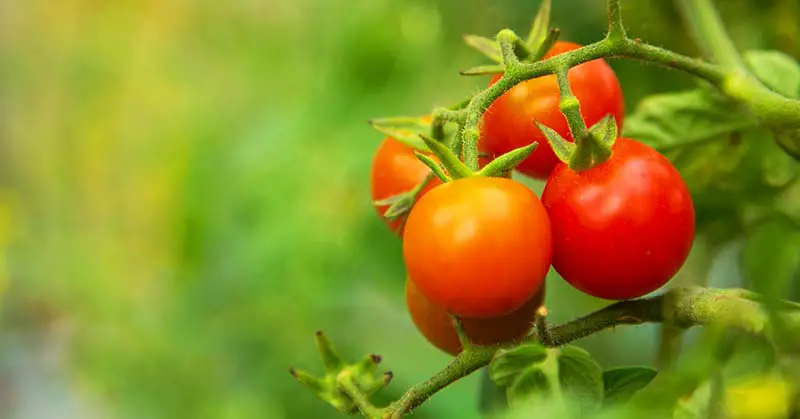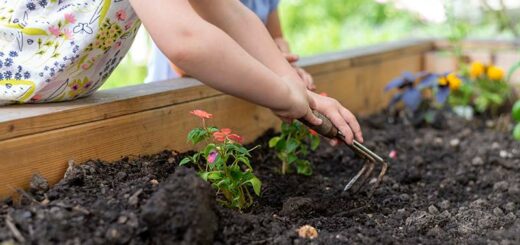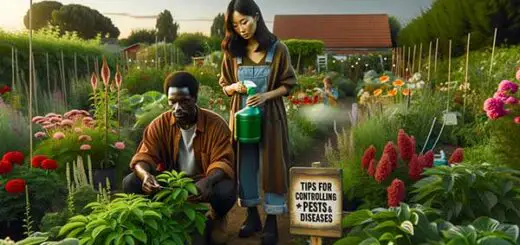How to Grow Hanging Tomatoes: A Step-by-Step DIY
Hanging tomato plants, or upside-down tomatoes as they’re often called, offer numerous benefits for both the casual home gardener and more serious horticulturists:
Space-saving: Hanging plants are an excellent way to utilize vertical space in your garden, especially for those with limited ground space. This makes growing tomatoes in apartments, balconies, or small yards possible.
Reduced Disease and Pest Issues: When tomato plants are grown above ground, they are less susceptible to soil-borne diseases and pests. This can result in healthier plants and better yields.
Improved Air Circulation: Hanging plants have better air circulation around them, which helps to prevent fungal diseases that can affect tomato plants.
Easy Harvest: Tomatoes grown in hanging planters are often easier to harvest because the fruit hangs down and is easy to see and reach. This reduces the chance of stepping on and damaging lower fruits or disrupting the plant while harvesting.
Aesthetic Appeal: Hanging tomato plants can add a unique visual appeal to your garden or balcony. They can be part of a creative landscaping or gardening design combining utility and beauty.
No Weeding: Since the plants are above ground, you don’t have to worry about weeding around your tomato plants.
Prevents Ground Rot: Hanging the plants prevents the tomatoes from touching the ground and developing rot or blemishes from the soil.
Reduced Need for Staking: Traditional tomato plants often require cages or stakes to support the plant as it grows. Hanging plants eliminate this need, simplifying the growing process.
In sum, hanging tomato plants can be a fun, practical, and productive way to grow tomatoes, regardless of your available space.

Why Choose Hanging Tomato Plants?
Discover why choosing hanging tomato plants might be the perfect solution for your gardening needs.
Benefits of Growing Tomatoes Upside Down
Growing tomatoes upside down, often in specially designed hanging containers, provides a variety of unique benefits:
Space Efficiency: This method suits those with limited gardening space. Hanging containers can be placed on patios, balconies, or indoors near a sunny window, maximizing vertical space.
Reduced Disease and Pests: Hanging your tomato plants can help keep them out of reach of ground-dwelling pests and decrease the incidence of soil-borne diseases.
Ease of Care: Upside-down tomatoes don’t require staking or caging, and weeding becomes a non-issue, as the plants aren’t in the ground.
Improved Air Circulation: With more space around each plant, air circulation is improved, which can help prevent the fungal diseases to which tomatoes can sometimes fall victim.
Easier Harvesting: Because the tomatoes hang below the plant, they are easy to see and pick. This can make the harvesting process quicker and gentler on the plants.
Prevent Ground Rot: When tomatoes are grown in traditional garden plots, fruit that comes in contact with the soil can rot. This isn’t an issue with upside-down planters.
Aesthetic Appeal: Besides being practical, hanging tomato plants can be beautiful. They add interest to your outdoor or indoor spaces and can be part of a unique decorative scheme.
Types of Tomato Plants Suitable for Hanging
When hanging tomato plants, you must be careful about your choice of variety. Smaller, more compact varieties that are lighter in weight are often best suited to this method of growing. Here are some types of tomato plants that are especially suitable for hanging:
Cherry Tomatoes: Varieties like ‘Sweet 100,’ ‘Sun Gold,’ ‘Yellow Pear,’ and ‘Cherry Cascade’ are particularly well-suited to hanging planters. These plants have small, light fruits and a naturally trailing growth habit that works well when planted upside down.
Roma Tomatoes: These are also a good choice. They’re larger than cherry tomatoes but small enough for a hanging planter. Some options include ‘Window Box Roma’ or ‘Roma VF.’
Bush or Determinate Tomatoes: These types of tomatoes grow to a specific size, set their fruit, and then stop growing. They’re a good option for hanging planters because they don’t get too large. ‘Tumbling Tom’ and ‘Better Bush’ are a few varieties to consider.
Small Beefsteak Tomatoes: Some compact varieties of beefsteak tomatoes can also be grown in hanging planters. ‘Bush Steak’ and ‘Patio Princess’ are two varieties to consider.
Remember, the mature plant’s size and the fruit’s weight are the most important factors when choosing tomato varieties for a hanging planter.
Avoid large, vining (indeterminate) tomatoes, as they can become too heavy and unwieldy for this growing method. Always check the plant tag or seed packet for information about the plant’s mature size and growth habits.
Materials Required for Hanging Tomato Plants
Embarking on the journey of growing hanging tomato plants requires some preparation. First and foremost, it’s vital to gather all the necessary materials. This comprehensive list will ensure you have everything needed to kickstart your upside-down tomato gardening adventure.
List of Materials Needed
Here’s a list of materials you’ll need to create your hanging tomato planter:
Hanging Container: You can purchase a specifically designed upside-down tomato planter or use a 5-gallon bucket or similar container. Ensure the container is deep enough for the roots to grow.
Tomato Seedlings: Choose a suitable variety for hanging. Generally, they yield smaller fruits such as cherry tomatoes or determinate (bush type) varieties.
Potting Mix: A lightweight, well-draining potting mix is best. It should be rich in organic matter for nutrition.
Drill: This will create a hole in the bottom of your container if it doesn’t already have one.
Newspaper or Landscape Fabric: This will act as a barrier inside the container to keep the soil in a while allowing water to drain.
Hook or Hanger: Depending on where you’ll be hanging your plant, you might need a sturdy pin or hanger. It must be strong enough to support the weight of a thoroughly watered plant with fruit.
Watering Can or Hose: A long-spouted watering can, or a hose with a gentle spray setting is ideal for watering your hanging plant.
Fertilizer: Tomatoes are heavy feeders, so a slow-release or liquid fertilizer designed explicitly for tomatoes or vegetables is essential.
Explanation of The Role of Each Material
Hanging Container: This is the main vessel where the tomato plant will be grown. It must be sturdy and have enough room for the roots to grow. A drainage hole is necessary to allow excess water to escape.
Tomato Seedlings: These are young tomato plants that you will grow in your container. Choosing a suitable variety is crucial, as not all tomatoes are suited to upside-down growing.
Potting Mix: This provides the growing medium for your plant. The potting mix should be rich in organic matter for nutrition and must drain well. It gives the roots something to grow in and helps retain moisture for the plant.
Drill: You’ll use this tool to create a hole in the bottom of your container if it doesn’t already have one. This hole is necessary for planting the tomato seedling and for drainage.
Newspaper or Landscape Fabric: Placed inside the container, this acts as a barrier to keep the soil in place while still allowing water to drain.
Hook or Hanger: This is needed to hang your plant in your desired location. It should be strong enough to support the total weight of the plant, the container, and the wet soil, particularly when the plant is fully grown and bearing fruit.
Watering Can or Hose: Hanging plants can dry out more quickly than those in the ground, so regular watering is essential. A long-spouted watering can, or a hose with a gentle spray will help you water without soaking the leaves or fruit.
Fertilizer: Tomato plants need a lot of nutrients to grow and bear fruit, especially in containers where nutrients can be washed away with watering. A slow-release or liquid fertilizer helps provide these necessary nutrients over the growing season.
Tips on Where to Buy or Find These Materials
Hanging Container: You can purchase specially designed upside-down planters online, at garden centers, or home improvement stores. Alternatively, any large bucket or plastic container could work, so consider checking out local thrift stores or recycling bins.
Remember, whatever you choose needs to be sturdy and have room for a good amount of soil.
Tomato Seedlings: These can be found at any local garden center, home improvement store, or farmer’s market during the growing season. Consider purchasing seeds online from a reputable seed company if you’re looking for specific varieties.
Potting Mix: This can be purchased from any garden center or home improvement store. A high-quality potting mix rich in organic matter is always a good choice.
Drill: If you still need one, drills can be found at home improvement stores or online. Some places also have tool-lending libraries where you can borrow one.
Newspaper or Landscape Fabric: Newspaper can be collected over time from your daily or weekly subscriptions. Landscape fabric can be purchased at a garden center or home improvement store.
Hook or Hanger: These are available at home improvement stores or online. Make sure to choose a sturdy hook or hanger that can handle the weight of a full-grown plant and a pot filled with wet soil.
Watering Can or Hose: These are commonly found at garden centers, home improvement stores, or online. A long-spouted watering can, or a hose with a gentle spray will help water your plant efficiently.
Fertilizer: A good quality tomato or vegetable fertilizer can be found at garden centers or ordered online. Read the labels to find one that suits the needs of tomato plants.
Step-by-step Guide to Creating a Hanging Tomato Planter
Getting your hands dirty in gardening can be both fun and rewarding. We’re ready to begin the process now that you have gathered all the necessary materials. Follow this step-by-step guide to create your hanging tomato planter easily and succeed.
Choosing the Right Container
Choosing a suitable container for your hanging tomato plant is crucial. The container size and type can significantly impact your plant’s growth and yield. Here’s what you need to consider:
Material: Containers can be made from various materials, including plastic, ceramic, clay, and metal. While all can work, plastic is often the best choice for a hanging planter because it’s lightweight, durable, and retains moisture well.
Size: The container needs to be deep enough to allow for sufficient root growth. A 5-gallon bucket or similarly sized container is generally a good choice for most tomato varieties. The container should also be sturdy enough to hold the weight of the soil, plant, and water without cracking or breaking.
Drainage: Whatever container you choose needs good drainage to prevent the soil from becoming waterlogged. If the container doesn’t already have a hole in the bottom, you’ll need to drill one.
Color: If you live in a sweltering climate, a lighter-colored container can be beneficial as it will absorb less heat from the sun, reducing the risk of the roots getting too hot.
Pre-made Upside Down Planters: If you prefer, there are also pre-made upside-down planters available online or at garden centers. These containers are specifically designed for growing plants upside down and often include a built-in hanger and watering reservoir.
Preparing the Container
Once you have chosen the suitable container, it’s time to prepare it for planting. Here’s a step-by-step guide on how to do it:
Drill a Hole: If your container has no hole in the bottom, you must create one. Using a drill, make a hole approximately 2-3 inches in diameter in the center of the bottom of the container.
Add a Barrier: Cut a piece of landscape fabric or newspaper to fit the inside of the container. This barrier should cover the hole you drilled but allow water to drain. This prevents the soil from washing out through the hole while allowing water to escape.
Attach the Hanger: If your container doesn’t already have a way to hang it, it is time to attach the hook or hanger. Ensure it is secure and robust enough to hold the weight of the container once it is filled with wet soil and a plant.
If you’re using a pre-made upside-down planter, it will usually have a built-in hanger.
Fill with Soil: Begin adding your potting mix to the container. Fill it about one-third of the way full. The soil should be loose and not compacted.
Add Fertilizer: Mix some slow-release granular fertilizer into the soil. This will provide nutrients for your tomato plant over the coming weeks.
Planting the Tomato Seedling
With your container ready, it’s time to plant your tomato seedling. This is a delicate process and requires careful handling of the young plant. Follow these steps for a successful planting:
Remove the Seedling from Its Current Container: Gently remove the tomato seedling from its current pot. Be careful not to damage the roots. You should squeeze the sides of the pot or tip it upside down while holding the main stem between your fingers to get the plant out.
Prepare the Seedling: Prune any lower leaves off the seedling, leaving only the topmost leaves. The part of the stem that was previously below these leaves will produce roots once it’s in the soil.
Insert the Seedling: Insert the stem of the tomato seedling through the hole in the bottom of your hanging container. The leafy top of the plant should be hanging out the bottom of the pot.
It’s helpful to have a second pair of hands for this step to hold the plant in place from the bottom while you add soil from the top.
Add Soil: Carefully add more potting soil to the container around the stem of the tomato plant. Keep adding until the container is filled to about an inch below the top rim. The soil should be firm but not compacted — it must drain well.
Water the Plant: Thoroughly water the plant to help settle the soil. The soil level may drop slightly after watering. If it drops too much, you can add a bit more soil.
Place in a Sunny Spot: Finally, hang your newly planted tomato in a sunny spot. Most tomatoes require at least 6-8 hours of sunlight daily, so a south or west-facing location is often best.
Caring for Your Hanging Tomato Plant
Tomatoes have specific care requirements to ensure healthy growth and a good yield. Here’s a rundown of what your plant will need:
Sunlight: Tomatoes require much sun – ideally 6-8 hours daily. Ensure your hanging plant is in a location where it can get plenty of direct suns.
Watering: Hanging plants dry out more quickly than ground, so regular watering is essential. Check the soil’s moisture level daily and water when the top inch of the soil feels dry. Be sure to water the soil, not the leaves or stem of the plant, to avoid disease issues.
Fertilizing: Tomatoes are heavy feeders, mainly when grown in containers. Apply a tomato or vegetable fertilizer per the package instructions every 2-4 weeks to keep your plant well-nourished.
Pruning: Some pruning can help improve air circulation and direct energy to fruit production. Remove any yellowing or diseased leaves promptly. You might also want to prune some of the shoots that form in the leaf axils to focus the plant’s energy on producing and ripening fruit.
Rotation: Rotate the container every few days to ensure all sides of the plant get equal sun exposure. This promotes even growth and fruit production.
Pest and Disease Management: Regularly check your plant for signs of pests or disease. Early detection and treatment can save your plant. Typical tomato pests include aphids, hornworms, and whiteflies. Diseases might present as leaf discoloration, spots, or wilting.
Harvesting: Harvest your tomatoes when fully colored and slightly soft to the touch. Regular harvesting encourages the plant to produce more fruit.
Final Thoughts
Creating a DIY hanging tomato planter is a fun and rewarding gardening project, but it also provides a practical solution for small spaces and a unique way to grow your food.
With suitable materials, a bit of know-how, and ongoing care, you can cultivate thriving tomato plants that add a touch of beauty to your outdoor space while also delivering a delicious and fresh harvest.
No matter your level of gardening expertise, this guide to “DIY Hanging Tomato Plants: Maximizing Your Yield In Minimal Space” has hopefully equipped you with the knowledge and inspiration to get started on your hanging tomato garden.



